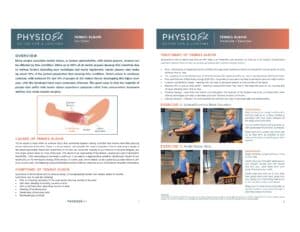Are you experiencing persistent pain in your elbow?
A variety of activities can cause elbow pain. Two of the most common elbow conditions are tennis elbow and golfer’s elbow or “golf elbow.” However, knowing whether you have tennis elbow or golf elbow can be tricky.
While both conditions can be difficult to treat, understanding their similarities and differences is the first step in effective pain management. In this article, we discuss determining whether you have tennis or golfer’s elbow, their common causes, and the best available treatments.
The Difference Between Tennis Elbow and Golfer’s Elbow
The technical names for tennis elbow and golfer’s elbow are lateral epicondylitis and medial epicondylitis. However, these conditions are not nearly as complicated as their names.
Like many common sports injuries, both tennis elbow and golfer’s elbow are repetitive stress or overuse injuries of the muscles in the elbow and forearm areas.
These two conditions are commonly confused due to similarities in their symptoms. To help you understand the difference, let’s break down each condition separately.
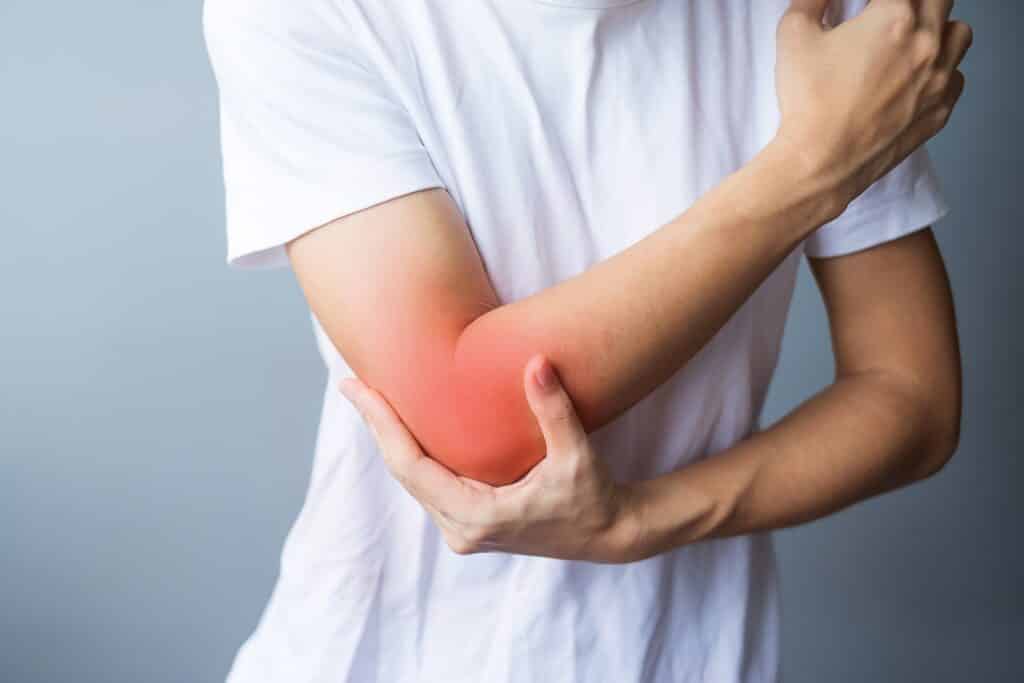
What Is Tennis Elbow?
Lateral epicondylitis, or tennis elbow, describes pain on the outer portion of the elbow and forearm muscles. The common extensor tendon, which is responsible for motions of the wrist and forearm (including a backhand tennis swing among other movements), is especially prone to repetitive stress injuries.
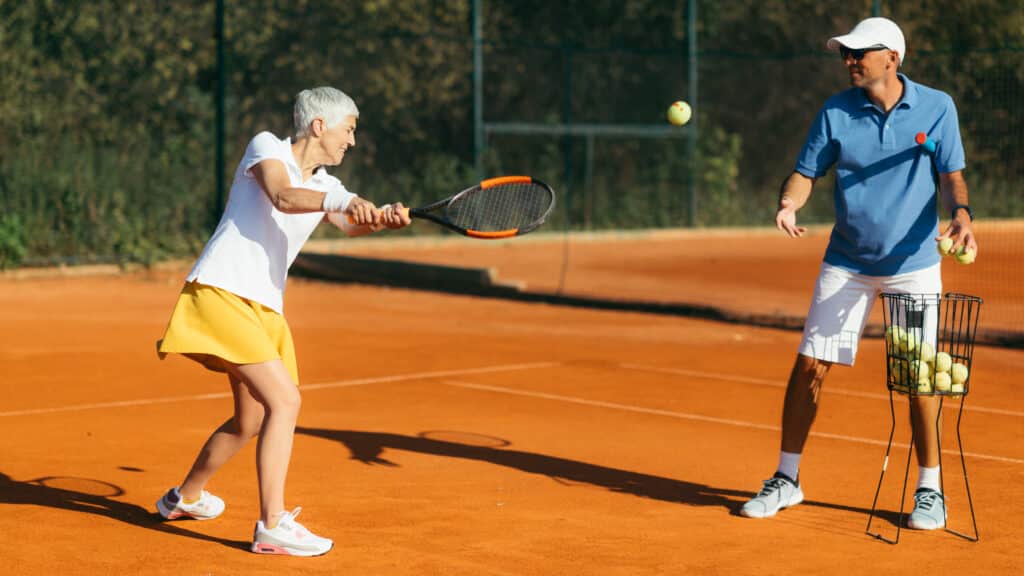
Causes of Tennis Elbow
Tennis elbow occurs either due to repetitive stress or weakened muscles at the elbow joint from underuse or injury, but tennis players are not the only ones who might deal with this pesky issue.
As tennis elbow develops, the tendons on the outside of the elbow connecting the muscles to the elbow joint become progressively more sensitive and painful. Developing tennis elbow may be sudden, but most people experience a slow progression of symptoms over the course of weeks or months. (1)
Although tennis elbow is traditionally named after sports with high rates of elbow injury (like tennis) you may develop these injuries during any upper body physical activity.
Surprisingly, even office workers without any history of sports or exercise may develop tennis elbow from repetitive tasks involving the hands and arms. (2)
Tennis Elbow Symptoms
Tennis elbow usually develops from overuse of the elbow, wrist, and forearm during sports, exercise, or repetitive activity at work.
Symptoms of tennis elbow include pain with gripping objects or extending (bending the wrist backward) against resistance, but it may also involve elbow pain when bending or straightening the elbow.
In most cases, physical pressure on the outer elbow will also be painful to the touch. (3)
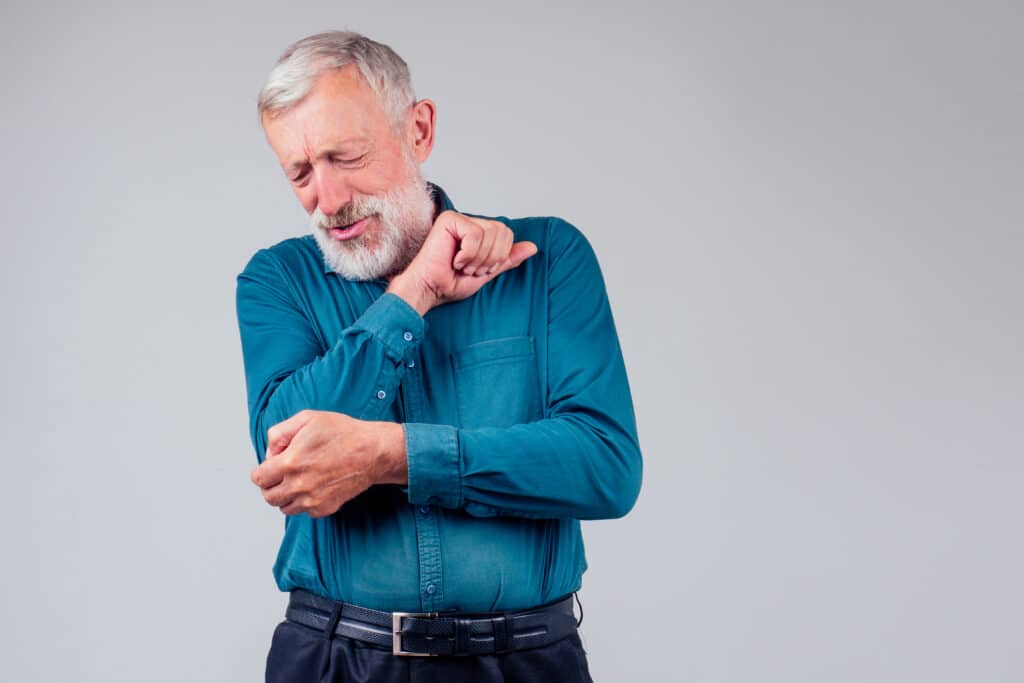
Tennis Elbow Treatments
At this point, you might be wondering “does tennis elbow ever go away?”
Tennis elbow can be challenging to cure, although there are many treatments available. Common treatments include massage to the outer elbow, use of non-steroidal anti-inflammatories (NSAIDs), and taking a break from painful activities.
In most cases, stretching or strengthening exercises can be performed to help the injured tendons heal properly. To determine the cause of your injury, we recommend consulting with your physical therapist to determine the best treatment plan for your tennis elbow symptoms.
In more severe cases, your doctor may recommend cortisone injections or platelet-rich plasma therapy to minimize pain and improve function in the affected tendon.

What Is Golfer’s Elbow?
Medial epicondylitis, or golfer’s elbow, describes pain at the inner elbow. Similar to the common extensor tendon for tennis elbow, the common flexor tendon connects many of the flexor muscles of the wrist and fingers. Due to its structure, this tendon is also very prone to repetitive stress injuries.
What Causes Golfer’s Elbow?
Just like tennis elbow, golfer’s elbow is very common and occurs either due to repetitive stress or deconditioning of the muscles at the elbow joint.
Golfer’s elbow can occur suddenly or slowly over time and usually begins limiting movement due to pain or discomfort in certain activities before it is diagnosed. (4).
While golfer’s elbow was originally named after a high-stress movement (swinging a golf club), this condition can develop during various sports or exercise routines. Just like tennis elbow, golfer’s elbow can be caused by non-athletic repetitive motions like computer mouse overuse.
Certain throwing sports can cause or exacerbate golfer’s elbow, including using poor throwing mechanics in baseball, or even javelin throwing

Golfer’s Elbow Symptoms
The term medial epicondylitis, or golfer’s elbow, simply describes persistent pain at the medial (or inner) bony border of the elbow, which is called the medial epicondyle.
In some cases, swelling or inflammation may also be present at the elbow, leading to increased tenderness and sensitivity to pressure.
Golfer’s Elbow Treatments
Luckily, treatments for golfer’s elbow are nearly identical to treatments for tennis elbow. These include massage, anti-inflammatory medications, relative rest, and guided physical therapy to facilitate stretching or strengthening exercises to restore the function of the elbow.
Your doctor or physical therapist may also recommend a golfer’s elbow brace to facilitate your recovery. Bracing can be important to reduce stress on your elbow during your daily activities, especially if you struggle with limiting your physical activity.

Similar Conditions That Can Be Mistaken for Tennis and Golfer’s Elbow
Making a determination between tennis elbow and golfers elbow can be challenging. Because tennis elbow and golfer’s elbow are both characterized by pain at the elbow, they may be mistaken for a handful of similar conditions. Here is a rundown of other elbow problems so you can talk to your doctor about symptoms to get the best possible treatment:
Muscle strains occur when a muscle or its tendon is overloaded, causing tearing and deformation of the tissue. These can be very painful, especially during resisted movement or muscle stretching.
Strains are classified as grade I (mild), grade II (moderate), or grade III (complete). While complete muscle strains or tears are difficult to mistake for tennis or golfer’s elbow, a grade I muscle strain can easily be mistaken for either of these conditions because symptoms are very similar.
Similar to muscle strains, ligament sprains occur when a ligament is overloaded, causing injury to the ligament. Ligament sprains are also graded on a similar scale, with grade III indicating complete ligament rupture.
Low-grade ligament sprains may also be mistaken for tennis elbow or golfer’s elbow because symptoms include outer or inner forearm pain with elbow movement.
Stress fractures are small cracks in the bone that develop due to excessive loading or impact. These may occur during an accident such as a fall or slowly due to repetitive high-stress movements during sports or exercise.
Stress fractures can go undetected because the associated symptoms of pain with resistance, soreness, and tenderness to touch can easily be mistaken for tennis elbow or golfer’s elbow.
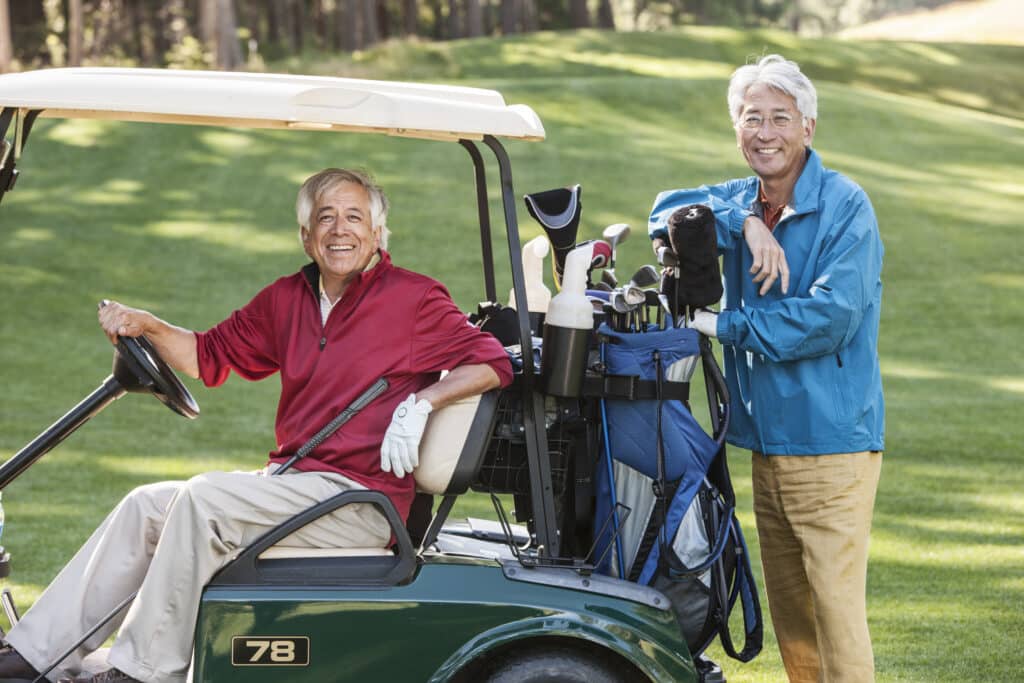
Key Takeaways
- Tennis elbow (lateral epicondylitis) and golfer’s elbow (medial epicondylitis) are repetitive stress injuries in the elbow region.
- Tennis elbow affects the outer elbow, while golfer’s elbow affects the inner elbow.
- Symptoms of both conditions may include pain during movement, tenderness, and, in some cases, swelling.
- Both tennis and golfer’s elbow can develop from non-athletic repetitive motions, such as computer work.
- Common treatments for both conditions include massages, NSAIDs, rest, and physical therapy.
- Diagnosis is complicated due to similar conditions like muscle strains, ligament sprains, and stress fractures.
FAQs
Is tennis elbow exclusive to tennis players?
No, tennis elbow can develop from various upper body physical activities, including repetitive tasks by office workers.
How long does it typically take for tennis or golfer’s elbow symptoms to appear?
While some may experience sudden symptoms, most people notice a gradual progression over weeks or months.
Are cortisone injections or platelet-rich plasma therapy standard treatments for severe cases?
Yes, in more severe instances, doctors might recommend these treatments to alleviate pain and enhance tendon functionality.
Can wearing a brace help in the recovery process of golfer’s elbow?
Yes, a golfer’s elbow brace is a common recommendation to reduce stress on the elbow during daily activities.
How can one differentiate tennis or golfer’s elbow from muscle strains or stress fractures?
Consultation with a medical professional is essential. While symptoms might overlap, thorough examination and imaging can pinpoint the exact issue.
References
- Johns, N., & Shridhar, V. (2020). Lateral epicondylitis: Current concepts. Australian journal of general practice, 49(11), 707–709. https://doi.org/10.31128/AJGP-07-20-5519
- Ma, K. L., & Wang, H. Q. (2020). Management of Lateral Epicondylitis: A Narrative Literature Review. Pain research & management, 2020, 6965381. https://doi.org/10.1155/2020/6965381
- Lenoir, H., Mares, O., & Carlier, Y. (2019). Management of lateral epicondylitis. Orthopaedics & traumatology, surgery & research : OTSR, 105(8S), S241–S246. https://doi.org/10.1016/j.otsr.2019.09.004
- Amin, N. H., Kumar, N. S., & Schickendantz, M. S. (2015). Medial epicondylitis: evaluation and management. The Journal of the American Academy of Orthopaedic Surgeons, 23(6), 348–355. Link: https://doi.org/10.5435/JAAOS-D-14-00145




